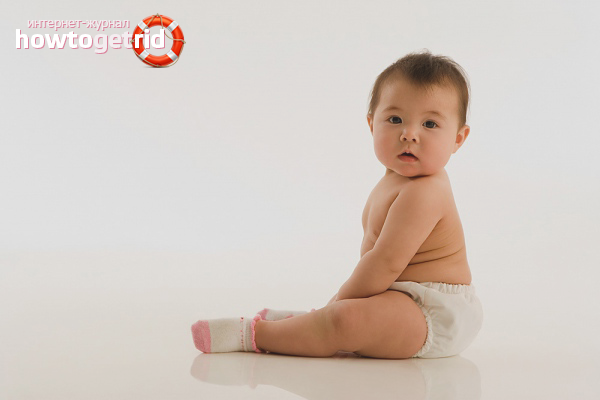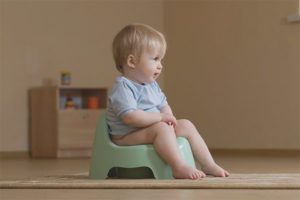The content of the article
The appearance of a child in the family is always a great joy, but also a great responsibility. Now you need to closely monitor the stages of its development and help the baby in all his attempts to go through these stages. Here you need to listen not only to your own feelings, the advice of relatives and special benefits, but also to the opinion of your pediatrician. It is this person who will reliably tell you about all the nuances and reassure you if your child deviates from these nuances a little.
Sooner or later, each parent raises the question of at what age it is best to start a child, and how to make this rule so that your actions do not harm the baby. After all, the bones and muscles in young children are not at all strong and easily injured.
Optimal age
The first and most logical question is about the age at which the child already needs to sit. This means that the bones and muscles have strengthened just enough to support the baby’s weight and not be overloaded. Here we are talking about the muscles of the abdominal press and chest and about strengthening the bones of the back - it is they who perform the main function of keeping the body upright.
By six months, these muscles and bones, as a rule, are formed properly, so the child, sitting down, does not experience discomfort and heaviness in the body. This is the best age to start teaching your baby to sit on her own.
But there are exceptions to each rule:
- You can start to sit down boys from the age of four, especially if he himself takes this initiative: grabs his fingers with his hands and pulls up or raises his legs and body, trying to sit down on his own.
- Girls are not recommended to be planted up to six months due to structural features of the body. Earlier sitting down of a girl can turn into big problems in adulthood, for example, a bend of the uterus, which can adversely affect childbirth.
Mistakes not to be made
Very often, having heard the advice of good friends who do not have a medical education, parents make gross blunders in accustoming their child to independent sitting. Below is written what you DO NOT NEED to do when you teach your baby to sit down.
- Cover it with a bunch of pillows or sit it, leaning on the pillow. The child should sit independently. The presence of soft support only relaxes the muscles and ligaments, which, on the contrary, must actively work and train. Let the baby learn longer without support, but his muscles and bones will grow stronger precisely, which in the future will help to avoid problems with posture.
- Use some kind of support. Generally forget about this word if you want to teach your child to sit. You can only help him in pulling up - it trains the abdominal muscles, but never sit the child, for example, near the wall of the crib - this again will lead to dysfunction of those muscle groups that should actively work.
Usually, by the age of seven months, the child can sit quietly on his own, not using your help and, especially, support. If the baby is tired, he will simply lie on his back or stomach and continue his activity.
Recommended Exercises
To be honest, your pediatrician should provide you with a list of general strengthening exercises at the scheduled examination in half a year. Usually it is on him that the doctor wonders if the child is sitting on his own. If in response he hears that the baby does not even make attempts to tear himself away from a flat surface, he will surely show you what exercises you should do so that the child begins to rise to a sitting position.
At the next examination, you will hear the same question, and if there is no progress, then you will be sent for an additional examination to a neurologist and orthopedist to exclude possible pathologies of the nervous system, muscles and skeleton.
If no diseases are found, then you will be strongly advised to pay more attention to exercises, it may be worthwhile to conduct a course of massage and physiotherapy exercises. All this strengthens the muscles and bones of the baby.
Here are some exercises for a child’s daily workout:
- You help the baby rise from the position of "lying on his back", holding his hands. Doing this is very gentle, remembering the fragility of the baby. You can start 3-4 times so that the child does not get tired too much. Over time, the number of approaches can be increased.
- Offer your child the fingers of your hands. He must grab them and pull himself up. To begin with, it will be nice to give the child both hands, but over time, offer only one, holding the baby’s legs under the knees. IMPORTANT: do not pull the child directly onto yourself, leave your hands in a fixed position, be sure to give him the opportunity to raise his body himself.
- Teach your baby to balance in space. To do this, set it on a flat surface without the possibility of resting on anything. In this position, you fix his legs with one hand, and hold his palm with the other. Gently guide his body in a circle, allowing the baby to feel the empty space around him. In this exercise it is permissible to put soft springy cushions around for safety.
- If you are going to buy a playpen, then take the one that has large cells. A child placed in it will have a good opportunity to pull themselves up, clinging to these same cells.
General strengthening exercises
Not only active classes contribute to the early learning of your baby's independent sitting. It is necessary to remember that it is necessary to strengthen the muscles and bones of the baby in all senses of the word.
- Help your child roll over from the stomach to the back and back. In the process, you can use your baby’s favorite toys to interest him: he will reach for the rattle and, accordingly, will actively move.
- Put the baby on your lap and put your hands in front of him so that he can hold on to them. Do not let the child rely on you (at least until he gets tired), let him learn to balance. To keep the child calm and not capricious, you can also distract him with toys or rhymes like “By bumps, by bumps”.
Why baby doesn’t want to sit
It is worth noting that often the desire of the baby is ahead of adult expectations. As the child grows, his motor activity also grows, and as a result of this, he himself will begin to attempt to sit down. As a rule, an innate craving for the knowledge of the world and independence excludes parental assistance: a curious and already active baby teaches himself to sit. But if by the age of six to seven months the child does not show due enthusiasm, and following the doctor’s instructions does not bring a positive result, you should think about going through a thorough examination with the baby.
Possible diagnoses that the examination may show you:
- latent (possibly prenatal or birth) injuries;
- skeleton abnormalities;
- muscle dystrophy;
- rickets;
- hypertonicity of the lower extremities;
- overweight.
Do not panic when you hear this from a doctor. All this is being treated in the conditions of modern technologies, it is possible to fight against it.
If the examination did not show anything like this, then you should calm down and not adjust your child to generally accepted concepts. Perhaps he will learn to crawl faster than he will learn to sit. Indeed, in every rule there are exceptions. In this situation, do not force events, you can do harm: only help, attention and care!
Neatly!
Never forget about safety: it is even in such a case. In your hands is a fragile baby, any careless movement can seriously harm him.
- You can not start planting a child if he is not ready for this and does not make attempts to tear his back and legs off a flat surface.
- You can not use additional support, whether it is the headboard, pillows or soft cushions, which are supposedly made just for this. The child must be able to navigate and balance in space, his muscles must actively work! Otherwise, this will result in problems with posture.
- If you have been diagnosed with hypertension, be sure to treat it! A kid with such a disease does not sit correctly: it rests on the buttocks and heels, while the spine is bent incorrectly. This will also lead to back problems.
- Do not worry if the child cries, trying to sit up from a standing position. This is obviously more difficult, he will cope with it by the year. If this does not happen, then take the baby to the doctor.
- A child who does not know how to sit can be rolled in a stroller with a hard back, which leans back to the “reclining” position. The walk should not last longer than an hour. Also, such a child can be put in a kangaroo, but, again, no longer than an hour.
All this is relatively easy, if approached correctly and wisely. Do not demand from your child more than he can do - do no harm. Make it a rule: do not rush things, but gently push them towards further development. Only in this way will your baby develop correctly and in accordance with his own program, laid down from birth.
Video: how to teach a child to sit












Submit